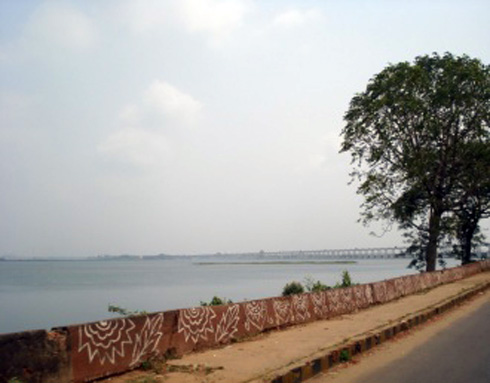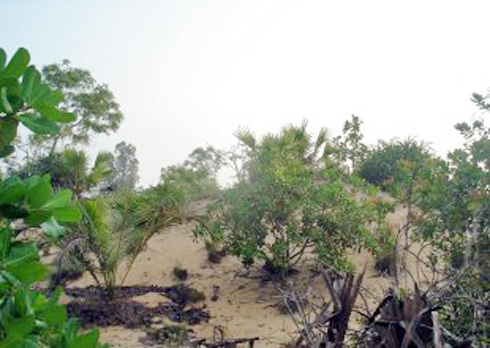“It is undisputed that as of today the Project Proponent does not have Environmental Clearance (EC). In fact by earlier judgment of the Tribunal, the permission granted to the Project Proponent was kept under suspension and it was to remain in force till an appropriate order in review or otherwise was passed by the Ministry of Environment and Forests (MoEF) on the recommendations of the Expert Committee. It is stated on Affidavit before us that proceedings are still pending and therefore EC in favour of the Project Proponent remains suspended.”
What this extract from the order of the National Green Tribunal (NGT) on 28 May, 2013 refers to is the fact that following an earlier NGT judgment of 30 March 2012, the environment clearance (issued under the Environment Impact Assessment Notification, 2006) for the steel plant and captive port for M/s POSCO India Ltd remains suspended until a full review as per the judgment is carried out. With the above facts on record, the NGT has issued a status quo on any further felling of trees in the area related to the project. A fact that might need to be altered soon with an expert appraisal committee (EAC) in the Ministry of Environment and Forests having approved the revalidation of the environment clearance for the steel plant, as seen in the minutes from 16 May 2013.

The Jobra barrage on the Mahanadi, from which water was to be sourced for the project. India Together File Illustration.
POSCO India Pvt. Ltd had sought environment clearance from the MoEF in 2006-2007 to set up an integrated iron and steel plant (4.0 MTPA) with a captive power plant (4x 100 MW) at Kujang near Paradip. The proposed initial capacity of the integrated steel plant was 4.0 MTPA with a planned expansion up to 12 MTPA, for which land was being acquired. Total project area for the steel plant is stated to be 4,004 acres, which includes 3,097 acres, (1,253.225 ha) of forestland and 907 acres of private land. 471 families of Dhinkia, Gobindapur, Nuagaon, Polanga, Bhuyanpai, Bayanal, Kandah, Noliasahi and Jatadhar villages would be affected by the acquisition. POSCO had simultaneously applied to the MoEF for approval for building a captive port, about 12 km south of the existing Paradip port. The proposed site is located mainly in Dhinkia, Gobindpur, Nuagana and Trilochanpur villages in the Jagatsinghpur district of Orissa.
In this region of unrest, people continue to face forceful acquisition of land, arrests and continued clashes with the state. Even as lives and futures are at stake and ecosystems face the threat of irreparable transformation; a series of reviews and plethora of litigative steps continue to find ways in and out of POSCO's Jagatsinghpur ambitions. Most recently, the judgment of the NGT in March 2012 and in particular, the findings of the Roy Paul Committee that was set up following the NGT's directions, have serious implications for regulatory life for POSCO.
With POSCO's 2007 clearances having lapsed and January 2011 approvals under suspension, the project is still being appraised by the Ministry's Expert Appraisal Committees. The Roy Paul Committee's contentions as well as POSCO's clarifications with respect to environmental clearance are in the thick of review by the MoEF.

•
Posco ruling sets new terms
•
Holding their ground against POSCO
Understanding the committee's context
The Ministry of Environment and Forests (MoEF) had set up a committee under the Chairmanship of K. Roy Paul pursuant to the March 2012 judgment and directions of the National Green Tribunal (NGT) on the proposed steel plant and port in Jagatsinghpur, Odisha. This expert committee was constituted on 29 May 2012 comprising of K. Roy Paul, Former Secretary to Government of India (Chairperson); Professor R. Ramesh, Director, National Centre for Sustainable Coastal Management; Dr. S. R. Wate, Director, NEERI and Director National Institute of Hydrology (Members). The coordinator of this process on behalf of MoEF was Dr. P. L. Ahujarai; Director, MoEF.
The terms of reference of the committee mandated a fresh review of the project with specific reference to the observations/apprehensions raised by the earlier 2010 Review Committee (also set up by the MoEF) in both its reports - one given by the Chairperson Ms. Meena Gupta and the other by the Majority Members. This is apart from consideration of the views of the EACs and also with reference to the observations made in the Judgment by the Hon'ble NGT dated 30 March 2012. The committee also needed to review, among other things, the issue of optimization of the total land requirement for the 4-MTPA Steel Plant (as the NGT judgment had made crucial observations on it) instead of land acquisition for a 12 MTPA plant, as well as the feasibility of creation of a captive water resource facility.
The committee held meetings during the visit to Bhubaneswar between 20-22 August 2012, the minutes of which have been included in the final submission made to the MoEF on 22 October 2012. This submission has still not been made public by the MoEF.

Sand dune at Dhinkia village, which has been a centre of resistance against the POSCO steel plant. Pic: Kanchi Kohli/India Together files.
The committee report
While there is a wide range of observations and recommendations in the Roy Paul committee report, discussed here are a few critical ones along with their implications:
One of the foremost things that the committee has asked for is substantial revision of the layout of the steel plant and re-submission of the plan based on optimization of land for a 4-MTPA plant. The report observes that based on information provided by IDCO, it has been decided to reduce the project area to 2700 acres, only by leaving out most of the private land of Govindpur and Dhinkia villages and the portion of forest land where betel vines were being grown by people of these villages.
This, therefore, implies that the project authorities would need to alter the project layout substantially and redraw the same in the light of the fact that Gates 2 and 3 of the project are within the area that needs to be excluded. Several plant facilities like the substation, plant substations, water supply facilities, main office etc related to Phase 1 of the project and the greenbelt are also within this area which is now to be excluded. But what this also means is that even if this alternative plan, leaving out two villages, is agreed upon the plant would encircle these villages, not giving them much of a choice in the future to continue to carry on their lives and livelihoods unhindered.
The committee has asked POSCO to unambiguously state whether the reduced project area will be able to accommodate all its future expansion plans. This would be important especially in the light of the Memorandum of Understanding (MoU) that POSCO had signed with the Odisha government back in 2005, which too has currently lapsed but had included a 12 MTPA plant and several other operations for which clearances have not fully been sought. Unfortunately, while several MoEF committees and the judgment of the NGT clearly highlighted the irregularities with the information provided by POSCO, the Roy Paul committee has once again put the onus on the company to give an unambiguous answer without holding them responsible for previous misinformation or accountable for any such act in the future. This could have been a critical aspect of their recommendations.
The Roy Paul committee makes very substantial observations on the number of studies and assessments which have not been carried out for the steel plant and port and therefore need to be undertaken. Some of these studies, including those listed in the final approval, include a periodic study on shoreline changes; source sustainability study of water requirement; marine environmental conservation plan; assessment of the impact on the local fishing community in terms of economic losses for mitigation and R&R (resettlement and rehabilitation); an oil spill management plan etc.
The committee has also recommended long term monitoring and studies of the impact of erosion of creeks/banks, deepening of the creek or widening of the river mouth and ecological changes occurring due to the construction of the project. What this actually means is that none of these studies has been carried out for the project during any of the earlier approval processes.
The issue of incomplete environment and social assessments, misleading data and need for comprehensive understanding of impacts prior to clearance is something that has been repeatedly brought up by a range of actors including the MoEF's own committee, ever since April 2007 when the public hearing of the project took place. Doing these studies post facto is futile, even if they are listed as part of clearance conditions, because it renders the findings to a fait accompli situation when a project has already been constructed partially or fully.
The committee has unequivocally observed that according to the information available and also the condition laid out in the final approval letter dated 31 January, 2011, a study of the water source availability for the company needed to be carried out. Availability of water is a critical issue in the area. Therefore, POSCO should submit complete information about water availability and water balance, the source of meeting water requirements, feasibility of creating a surface within the project area etc. This is especially so because the state irrigation department has stated that POSCO should not claim to get the total quantum of water needed to meet the entire requirement during the non-monsoon and lean periods as a matter of right. While the committee recommends that this needs to be evaluated by the EAC, it does not question why earlier approvals for the project were given without a full assessment of the same.
Some of the other recommendations of the committee include a fresh clearance under the Coastal Regulation Zone notification, 2011 for the road project and a High Level Monitoring committee for project compliance. It has also made observations on shoreline management, waste water treatment as well as rehabilitation and Corporate Social Responsibility (CSR) aspects.
Where are we today?
The observations and conclusions of this Committee's report have been part of the review of the environment clearance of the steel plant and port being carried out by the MoEF's Expert Appraisal Committee (EAC) on Industry. Two meetings of the committee on 5-6 March 2013 and 16 May 2013 have already taken place where the report has been tabled, discussed and additional information sought from the company. It has only been a few days since the minutes of the May meeting were made available by the MoEF. The EAC has recommended the revalidation of the 2007 environmental clearance based on the information received from POSCO in April 2013. The decision includes yet another set of conditions that have been added to the project clearance, and ironically many of them don’t have much to do with the substantive observations of the NGT judgment or even the Roy Paul committee report.
The future for POSCO and its implications for Jagatsinghpur still hang in balance and it is not unlikely that the latest decision of the EAC will find itself in another challenge. What continues to be evident though, with yet another conditional approval for POSCO, is that the project continues to be pushed through by the highest offices in the government despite long standing lacunae and illegalities that are far from being resolved. For the political struggle, it poses one more threat and presents another instance where one of India's highest FDI projects is getting ready to bulldoze itself into the area. The nature of confrontation this may bring will not be difficult to imagine for anyone who seeks to understand the history of resistance to POSCO in Jagatsinghpur.























